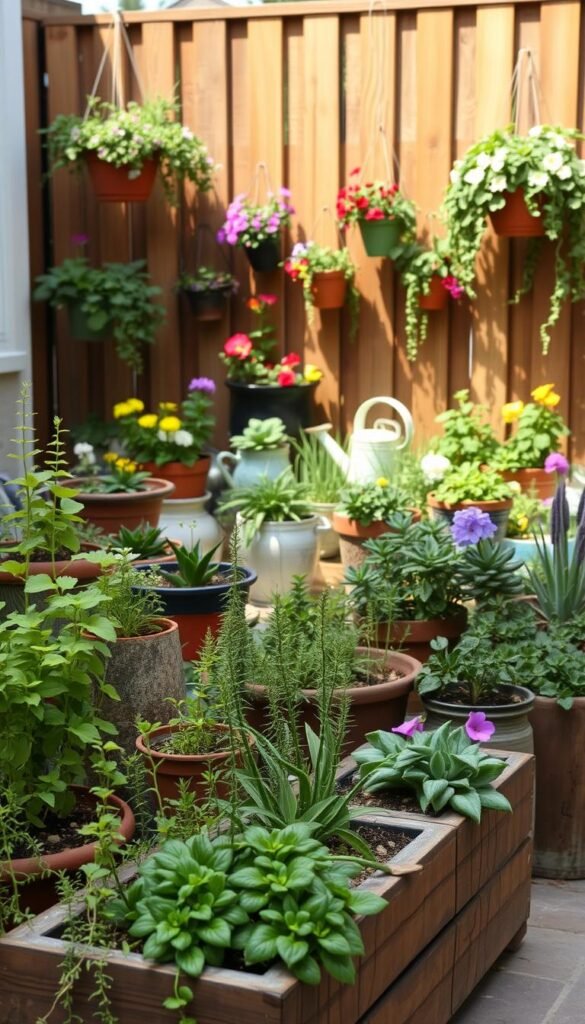Turning limited outdoor spaces into vibrant growing zones might seem challenging, but creative solutions make it surprisingly simple. Whether you’re working with a balcony corner or narrow windowsill, clever design lets you cultivate beauty and functionality side by side.
Vertical arrangements and multi-level planters unlock hidden potential in cramped areas. Discover how hanging herb gardens or stacked container systems can multiply your planting space while adding visual depth.
Your urban oasis becomes practical through smart plant choices. Dwarf fruit trees thrive in pots, while compact vegetables like cherry tomatoes deliver fresh flavors. Combine edible plants with colorful blooms like petunias for dual-purpose beauty that excites both eyes and taste buds.
Budget-friendly projects turn everyday items into unique planters. Repurpose old crates, teacups, or even rain boots using our space-saving design tips. These approaches let you experiment without breaking the bank while reducing waste.
Proper planning ensures success in confined areas. Learn how sunlight patterns and plant spacing impact growth. With the right strategies, even first-time growers can create thriving green spaces that refresh their homes daily.
Designing Your Mini Herb Garden Planter
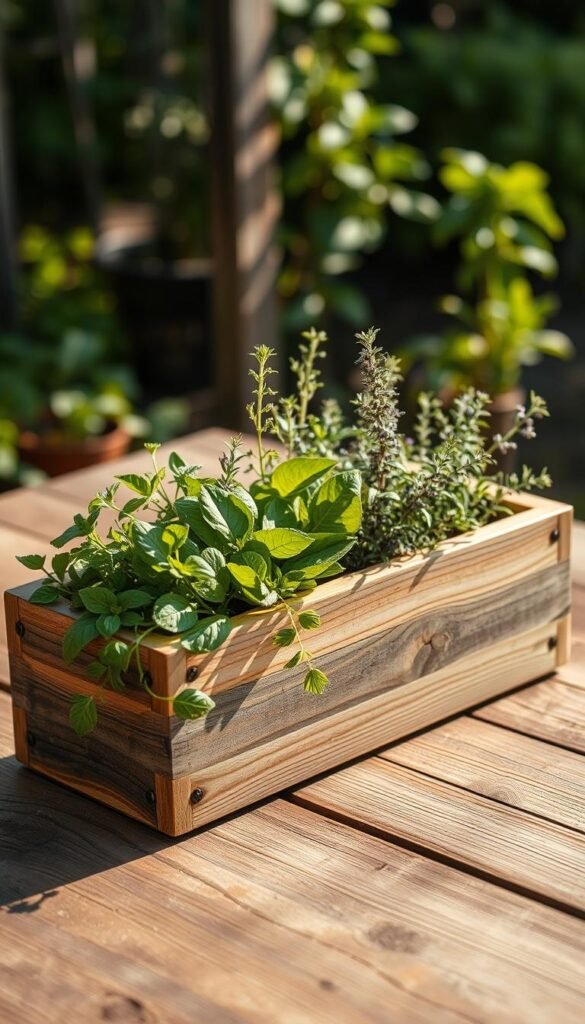
Fresh herbs transform everyday meals into vibrant culinary experiences. Imagine plucking aromatic leaves seconds before tossing them into your skillet—this setup keeps flavors at their peak while adding greenery to your space.
Selecting the Ideal Container
Drainage holes are non-negotiable—herbs hate soggy roots. Choose pots deep enough for root growth (6-12 inches works for most varieties). Lightweight materials like resin or fiberglass make moving planters effortless when seasons change.
Basil thrives in containers, with Genovese perfect for pesto and Thai adding spice to stir-fries. Pair it with rosemary or thyme in larger planters, but give each herb room to breathe. Alice and Louis recommend separate pots for aggressive growers like mint.
Herb Care Tips for Year-Round Use
Rotate pots weekly so plants get even sunlight indoors. Water when the top inch of soil feels dry—overwatering kills more herbs than neglect. Snip leaves regularly to encourage bushier growth.
When frost threatens, transition plants gradually. Start by bringing them inside for a few hours daily over a week. Place near south-facing windows where possible, or use grow lights during darker months. With this approach, your parsley and cilantro will keep producing through winter.
Upcycling Vintage Furniture for Charming Planters
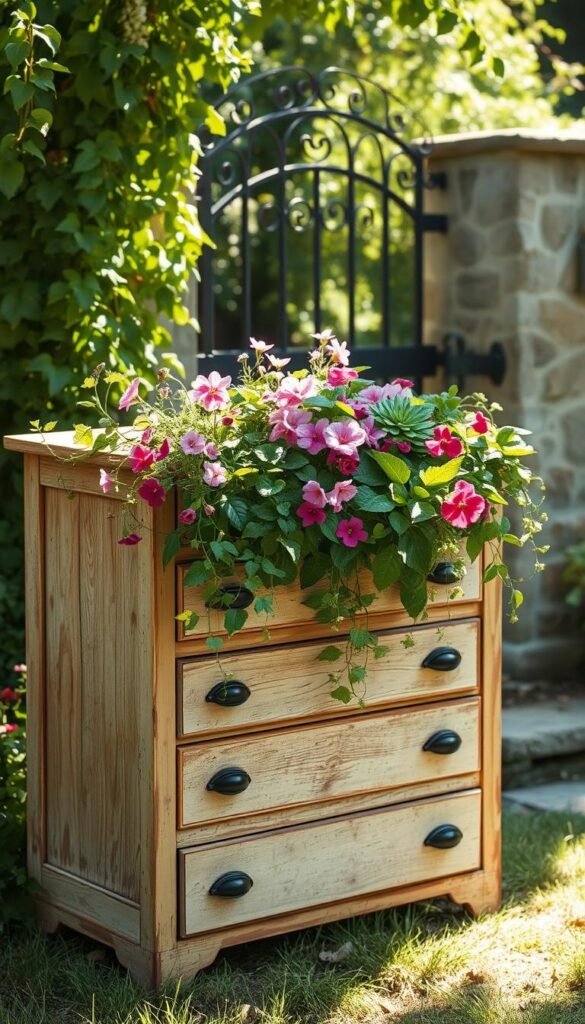
That chipped dresser gathering dust in your garage? It’s secretly a showstopping planter waiting to happen. Repurposing vintage furniture adds instant personality to your garden while keeping usable items out of landfills. With some creativity, you can turn forgotten treasures into functional art pieces that spark conversations.
Choosing Unique Vintage Pieces
Start your hunt at thrift stores or estate sales—look for sturdy items with character. Dresser drawers become tiered herb gardens, while bathtubs transform into sprawling flower beds. Prioritize pieces with flat surfaces and enough depth for root growth. Avoid particle board furniture unless you’re creating temporary displays.
Simple DIY Restoration Steps
First, drill drainage holes—this non-negotiable step prevents waterlogged plants. Clean surfaces thoroughly, then apply outdoor-safe sealant to protect against weather. Line metal containers with landscape fabric to prevent soil contact with rusty surfaces. For patio displays, consider adding casters to heavy pieces for easy rearranging.
Trailing patio container gardening favorites like ivy geraniums or sweet potato vine soften angular furniture edges beautifully. Cluster smaller planters on shelves of a repurposed bookcase, or let climbing roses spill from a retro filing cabinet. The key? Let the piece’s original charm shine while making it work for your plants’ needs.
Creating Atmosphere with Hanging String Lights
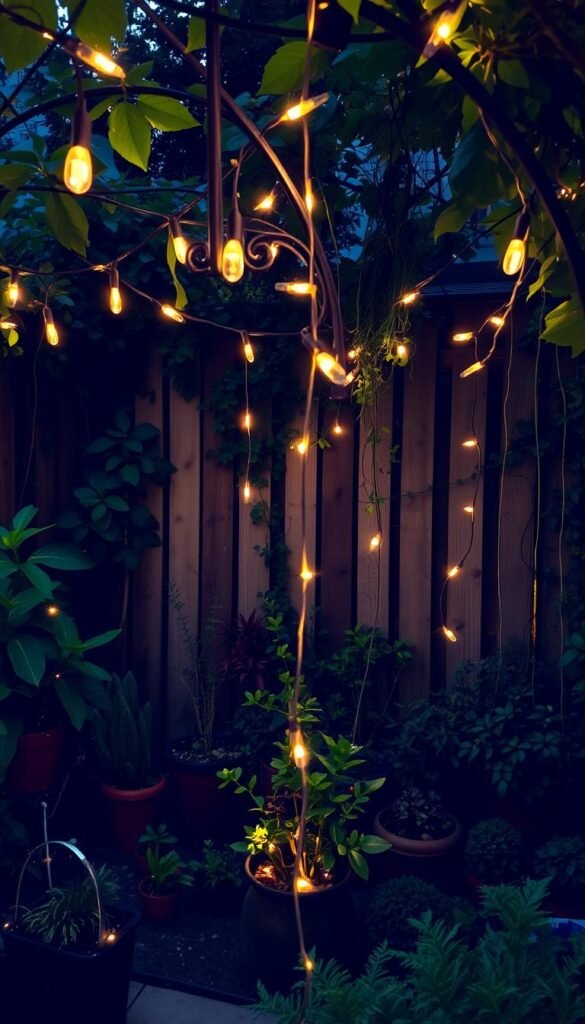
Even the coziest nook becomes enchanting when draped in twinkling lights. Soft illumination transforms your outdoor area into a welcoming retreat where flowers glow at dusk and leaves cast delicate shadows. For year-round magic, choose weather-resistant designs that shine through summer showers and winter frosts.
Tips for Safe and Waterproof Installations
Start by selecting UL-certified lights rated for outdoor use. Brands like Getty Images-featured designs offer both style and durability. Avoid overloading circuits—space multiple strands evenly across your hanging zones.
Use these strategies for seamless setups:
| Light Type | Best For | Weather Resistance | Installation Tips |
|---|---|---|---|
| Solar LED | Eco-friendly zones | High | Place panels in full sun |
| Incandescent | Warm ambiance | Moderate | Use under covered porches |
| Waterproof LED | Rain-prone areas | Excellent | Secure with gutter hooks |
Wrap strands around plant trellises or drape them along porch railings for layered effects. Always test connections before mounting, and use insulated clips to protect surfaces. Combine with lanterns or pathway markers to guide eyes through your illuminated sanctuary.
With thoughtful placement, your evenings gain new charm. Continue reading to discover how water features enhance these glowing spaces further.
Adding a Serene Bird Bath Focal Point
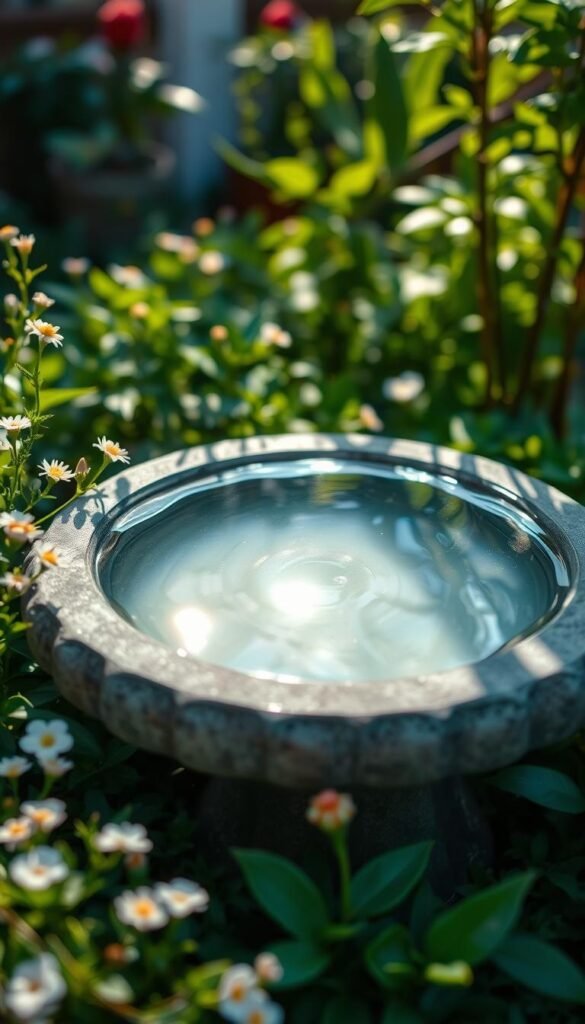
A shallow pool of water becomes nature’s invitation in even the tiniest outdoor areas. Positioned among plants or nestled near seating areas, a bird bath adds life and motion to your yard. Choose designs that match your space—shallow bowls for sparrows or tiered options for butterflies.
Maintenance and Cleaning Advice
Refresh water every 2-3 days to deter mosquitoes. Scrub surfaces weekly with a vinegar solution to remove algae without harsh chemicals. In winter, use heated models to prevent ice buildup.
| Task | Frequency | Tips |
|---|---|---|
| Water Replacement | Every 48 hours | Use room-temperature water |
| Deep Cleaning | Monthly | Baking soda for stubborn stains |
| Seasonal Prep | Spring/Fall | Check for cracks or leaks |
Attracting Local Wildlife
Place your bath near greenery where birds feel safe approaching. Add flat stones for butterflies to perch while drinking. Native flowers like coneflowers or milkweed nearby provide nectar and shelter.
You’ll soon spot robins splashing at dawn and hummingbirds sipping at dusk. Continue reading to learn how seating areas let you enjoy these moments firsthand.
Relax Near a Garden Bench and Enjoy the View
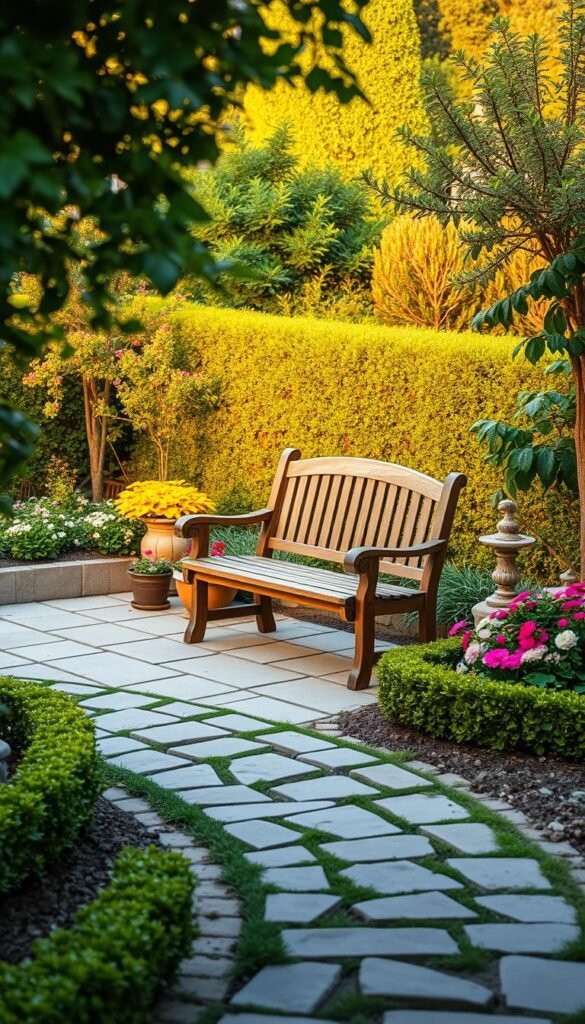
Your garden becomes a personal retreat when you add a simple bench—it’s where beauty meets comfort. Flank it with vibrant flowers in ceramic pots, and you’ve created an ideal spot to look over your thriving outdoor space. This setup turns fleeting moments into cherished pauses, whether you’re sipping coffee at dawn or stargazing after sunset.
Position your seat to highlight your favorite features. Face it toward blooming hydrangeas, a bubbling fountain, or bird feeders buzzing with activity. Rotate decorative pillows seasonally—bright citrus hues for summer, warm plaits for fall—to keep the area inviting year-round.
Consider these elements when choosing materials:
| Material | Durability | Comfort | Style Match |
|---|---|---|---|
| Cedar Wood | High | Natural warmth | Rustic gardens |
| Powder-Coated Metal | Weather-resistant | Add cushions | Modern spaces |
| Recycled Plastic | Low maintenance | Molded curves | Coastal themes |
Use side tables made from repurposed tree stumps or stone slabs to hold drinks and gardening tools. String fairy lights overhead for evening ambiance, or train jasmine vines along the backrest for fragrant daytime lounging.
This welcoming nook naturally becomes your favorite place to unwind and observe visiting butterflies. Continue reading to discover how specific plants can turn your sanctuary into a wildlife haven.
Integrating Plants That Attract Wildlife
Transform your outdoor area into a lively ecosystem by welcoming nature’s helpers. Selecting the right greenery turns your cozy corner into a buzzing hub for bees, butterflies, and birds—each visit strengthens your garden’s health.
Choosing Pollinator-Friendly Varieties
Native blooms like coneflowers and goldenrod work overtime, offering nectar through multiple seasons. Cluster these plants in groups of five to help pollinators spot them easily. Dwarf sunflowers thrive in pots, while thyme in window boxes feeds bees without demanding much space.
Milkweed becomes a monarch nursery when planted near seating areas. Pair it with zinnias for continuous color from spring through fall. For detailed steps on creating a pollinator haven, explore our seasonal planting guides.
Remember: diversity sustains life. Mix early bloomers like wild lupine with late stars like New England aster. This way, your garden supports wildlife year-round while staying vibrant in every season.

